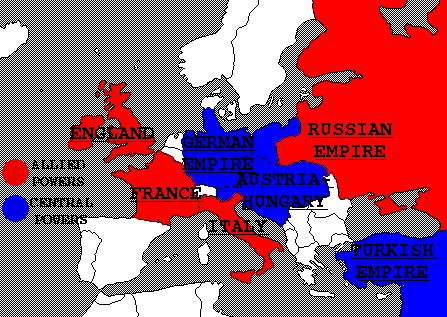 |
Countries that fought in WW1.
Allies vs. Central Powers. Source. |
World War I, or otherwise known as the "Great War" was one the most significant war. It included many different countries around the world. There were two armies, one called the Allies, and the opposing side called the Central Powers. The Allies mainly included Great Britain, Russia, France, Italy, and the United States. The Central Powers were mainly Germany, Austria-Hungary, Bulgaria, and the Ottoman Empire.
There were many interesting things about this war.The one I found most interesting was that trench warfare, when the opposing troops fought each other from a series of narrow ditches, which lasted three years with barley any progress made. They were also infested with rats, diseases, and you ran the risk of getting shot and killed during the fighting. One of the most significant things about World War I in my opinion was that it was caused by such a small dispute. However the death of Archduke Franz Ferdinand was technically what started the war, it was actually a series of events leading to the "power keg" to exploding.
 |
| Evolution of warfare. |
One thing I learned about World War I was that it was caused by bad alliances, imperialism, nationalism, and militarism. I also learned that trench warfare lasted for about three years with little to no progress on each opposing side. Because of these fighting techniques, we have adapted to using new fighting strategies. Now, how we fight in war is very distinct from how we war used to be fought. Now, we have new advanced and sophisticated weapons. Some examples of advanced weapons would be drones, jets or planes, and radios. Also, another difference would be that women are now allowed to fight in wars. In addition, during 1914, wars were fought with big armies in one big field. Now in 2015, wars are won by sending in small teams to either capture or kill the enemy target/leader using stealth during the evening or night. By doing so, many lives are saved while still getting the job done.
On November 11, 1918, the allies were able to win the war against the Central Powers. At first the U.S. didn't feel the need to join the war for many reasons. Some of those reasons were that no U.S. lives or property were at risk and it was very far away. However, in 1917, the U.S. finally joined the war to collect debts the Allies owed to them. A year after the U.S. joined the war, they defeated the Central Powers, proving that the U.S. was indeed one of the strongest countries ever.








